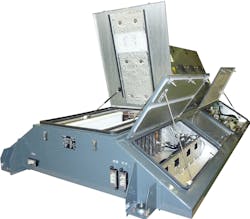New Carbon Dioxide Air Conditioning System — a Milestone
At InnoTrans 2016 in Berlin, Vossloh Kiepe presented the energy-efficient innovations of its new HKL751-CO2 air conditioning unit for railway vehicles, a major contribution to environmental protection.
Carbon dioxide (CO2) is experiencing a renaissance in air conditioning and refrigeration engineering. Triggered by the ongoing discussion on an adequate substitute for the standard refrigerant R-134a, the call for CO2 air conditioning systems has recently become increasingly audible. Vossloh Kiepe already decided several years ago to focus on the climate neutral refrigerant R744 (carbon dioxide, CO2) and has since contributed to several research projects and prototype trials. After all, the Global Warming Potential (GWP) of the R-143a and R-407C refrigerants is approx. 1300 and 1650, respectively, or in other words, R-407C has a greenhouse gas effect that is 1,650 times more severe than that of the same quantity of CO2.
Carbon dioxide also offers other material advantages, such as high volumetric cooling capacity, non-flammability and low toxicity.
Yet Vossloh Kiepe Austria, the Vienna-based subsidiary of Vossloh Kiepe specializing in VAC engineering, was not satisfied with merely switching to carbon dioxide but also aimed at improvements from a cost-benefit aspect. Employing the system as a heat pump opens up completely new avenues. As a result, the A/C unit with the type designation HKL751-CO2 not only has an interface that allows using the waste heat of surrounding components but also features a heat recovery function which makes for a particularly energy-efficient and hence resource-saving operation. Also the frequency-controlled compressor and the electronic expansion valve add to its energy efficiency. For use at particularly low outside temperatures, the compact air conditioning unit for rooftop installation is additionally equipped with a 24 kW heating system.
The HKL751-CO2 was especially developed for railway applications. Even at service pressures of up to 120 bar, the materials and components employed satisfy all technical requirements of the railway sector. Two of the A/C units shown at InnoTrans will be commissioned in September 2016 in a new prototype train of Deutsche Bahn AG.
“The new air conditioning unit is a milestone on the way to further developments,” said Project Manager Milos Weissensteiner. “Wherever permitted by the constraints of envelope, weight and interfaces, an application for other vehicle platforms such as trams or metros is generally possible.“
